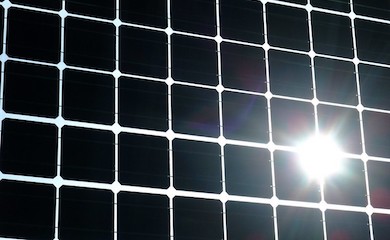Overview
Solar Photovoltaic generation systems can be installed anywhere including locations with no mains electricity. These off-grid systems can be used to power lights, irrigation pumps, televisions, fans, refrigerators, air conditioners as well as laptops and phones.

Figure 1: Indian Off-Grid solar system used for irrigation
System Design
A typical off-grid system costing around £1,000 consists of three solar panels, two batteries, an inverter and small distribution board. The panels are similar to standard rooftop panels and the batteries are similar to standard car batteries. The inverter electronics are housed in a casing which is about the same size as one of the batteries. The batteries allow people to use power at night after solar generation ceases.
Installation Worldwide
Regions that benefit most from these systems include South Asia and sub-Saharan Africa. Off grid solar systems are often used in areas with unreliable conventional electricity supplies to provide more reliable electricity – these grid connected systems are known as hybrid systems.
In 2019 35 million new off-grid solar systems were installed worldwide bringing the worldwide total to an estimated 420 million off-grid systems. At the moment it is estimated that 850 million people do not have access to electricity – representing 12% of the world’s population.
Economic Benefits
There is a widely held belief that access to reliable electricity drives development and alleviates poverty. Research in Western Kenya compared two population samples – one that was provided electricity and one that was not. This research did not show that provision of electricity reduced poverty. It seems, from the research, that access to electricity is an indicator of wealth – but not necessarily a key driver for the elimination of poverty. Other interventions such as improving water supplies, health care, education and sanitation may actually be better at reducing poverty. Various charities and organisations are nevertheless promoting the development of electricity for people who do not have it.
Continued Growth
Off grid solar systems are likely to continue to be installed at a rate of around 35 million systems per year with most systems being funded by “normal” consumer demand and economics and around 20 – 25% being funded by charities and government programmes to alleviate poverty. Off grid solar systems are likely to have significantly reduced the number of people without access to electricity by 2030 – perhaps to around 500 million (7% of the world’s population).
About Pager Power
Pager Power undertakes technical assessments for Renewable Energy developers. These include glint and glare assessments for solar PV systems as well as radar impact assessments for wind farms.
References
Image accreditation: https://commons.wikimedia.org/wiki/File:Farmers_surrounding_a_solar_water_pump.jpg



